#Indian Popular food Recipes
Explore tagged Tumblr posts
Text
Medu vada - South Indian Crispy Savory Donut
#Authentic Medu Vada#Best Medu Vada Recipe#Crispy Urad Dal Fritters#Crispy Vada Recipe#Deep Fried Lentil Fritters#How to Make Medu Vada#Indian Breakfast Vada#Medu Vada#Medu Vada Tips and Tricks#Medu Vada Variations#Medu Vada with Coconut Chutney#Popular Indian Street Food#Savory Urad Dal Doughnuts#South Indian Medu Vada#South Indian Snacks#Traditional Medu Vada#Urad Dal Fritters#Urad Dal Vada#Vada Batter Recipe#Vegan Indian Snacks
0 notes
Text
Paneer Butter Masala Recipe – How to Make Delicious Paneer Butter Masala at Home
Paneer Butter Masala Paneer Butter Masala, a popular Indian dish featuring paneer cooked in a luscious tomato-based gravy with aromatic spices.Paneer Butter Masala (Paneer Makhani, Butter Paneer) is one of the most popular Indian curries served worldwide. It is a rich and creamy curry where paneer cubes (Indian cottage cheese) are simmered in an onion tomato gravy. This is one of the most…
#Authentic Paneer Butter Masala#Best Paneer Butter Masala recipe#Butter Paneer#Creamy tomato gravy#Easy Paneer Butter Masala recipe#Homemade Paneer Butter Masala#How to make Paneer Butter Masala#Indian cottage cheese recipes#Indian food recipes#Indian Vegetarian Curry#North Indian Cuisine#Paneer Butter Masala#Paneer Butter Masala with basmati rice#Paneer Butter Masala with naan#Paneer curry recipe#Paneer Dishes#Paneer in tomato-based gravy#Paneer Makhani#paneer recipes#Popular Indian dishes#Restaurant-style Paneer Butter Masala#Rich and creamy Paneer Butter Masala#Spicy paneer recipes#spicy veg recipes#Traditional Indian cooking#Vegetarian dinner ideas#Vegetarian Indian dishes
0 notes
Text
https://www.travenix.com/best-north-indian-foods-popular-hyderabad/
Indulge in mouthwatering North Indian delights! Hyderabad offers iconic dishes like Rajma Chawal, Chole Bhature, Paneer Tikka, and Dal Makhani
#North Indian Food In Hyderabad#authentic hyderabadi recipes#hyderabad traditional food#hyderabad famous food items#must try food in hyderabad#famous food of hyderabad#popular food in hyderabad#hyderabad indian restaurant near me
0 notes
Text
good places to start with when looking for broad variety of indian recipes in english, biased towards north and south indian cuisine.
popular indian celebrity chefs with recipes/videos online: sanjeev kapoor, tarla dalal, ranveer brar (overcomplicates recipes imo)
national newsmedia that have recipe sections: ndtv, times of india, the hindu
288 notes
·
View notes
Text
Hetalia characters with dishes typical for their country - part 1 (part 2 here)

Italy: Maritozzo (cream bread) -> This Roman milk bread is said to be dated back to times of Ancient Rome. The baked good is filled with generous amounts of whipped cream and somtimes decorated with fruit or pistachio. Young man also used it in courtship by hiding jewellery or a ring in the filling.

Germany: Breze(l) mit Schokolade (chocolate dipped pretzel) -> A baked pastry with sweet or salty toppings, best known for its distinctive symetrical, knotted shape. Dipped in chocolate the soft pretzel is a popular snack at funfairs and markets, but there are also small, crispy pretzels that are to be eaten like crisps/chips.

Japan: 和菓子 (wagashi; plant based sweet) -> Originally meaning "Japanese confectionery" the term now refers to a traditional dessert made from plant based ingredients. It's artful shapes are influenced by season, nature, or even poetry.

France: Quiche Lorraine -> A savoury tarte traditionally made with a filling of eggs, heavy cream, ham, and bacon. Today cheese is often added, though it is controversial among professionals. (In the drawing there seems to be leek added too which is not mentioned in the original recipe either.)

England: Scotch Egg -> Supposedly inspired by the Indian nargisi koftas, this dish consists of a hard-boiled or soft-boiled egg wrapped in pork (sausage meat) which is coated in breadcrumbs and then baked or deep-fried. Often served in pubs and a popular cold snack as well.

America: Hamburger -> A popular fastfood consisting of a patty (traditionally made from ground beef) between two halfs of a sliced bun. There are countless variations made with all kinds of additional ingredients and condiments, including expensive high-end versions with edible goldflakes.

Russia: пирожки́ (Pirozhki; stuffed bread) -> This popular street food is a baked good made from yeast-dough is typically boat-shaped and filled sweet or savory with meat, vegetables, fruit, jam or tvorog (an Eastern European fermented milk product with a consistency similar to curd cheese)

China: 小籠包 / 小笼包 (Xiaolongbao; steamed bun) -> Steamed dumplings made from leavened or unleavened dough traditionally filled with minced pork, traditionally eaten for breakfast. The top of the dumpling is closed by folding and pinching it. Authentical dumplings have at least 14 folds, preferably 18.
#aph england#aph america#aph france#aph russia#aph germany#aph italy#aph japan#aph china#hws italy#hws germany#hws japan#hws england#hws america#hws france#hws russia#hws china#hetalia#riva.edit#source in the source#full disclaimer I tried my VERY best to find everything but if I made a mistake pls let me know (politely)
176 notes
·
View notes
Text
Allkindaideas - Platin
When it comes to dinner ideas, there are countless options to choose from. Whether you're looking for a quick and easy meal or something more elaborate, the possibilities are endless. One popular dinner idea is to create a themed meal, such as a taco night or a pasta bar. This allows for customization and variety, as each person can choose their own toppings and ingredients. Another option is to try out new recipes from different cuisines, such as Indian, Thai, or Mexican. This not only introduces new flavors and spices into your meals but also expands your culinary horizons. Additionally, incorporating seasonal ingredients into your dinner ideas can provide a fresh and vibrant twist to your meals. By using ingredients that are in season, you can take advantage of their peak flavor and nutritional value. Whether it's a hearty soup in the winter or a refreshing salad in the summer, seasonal ingredients can elevate your dinner ideas. When it comes to drawing ideas, the possibilities are truly endless. One popular option is to draw from nature, capturing the beauty of landscapes, flowers, or animals. This allows for creativity and exploration of different textures and colors. Another idea is to draw portraits, either of people or animals, focusing on capturing their unique features and expressions. This can be a great way to practice observation and improve your drawing skills. Additionally, abstract drawing can be a fun and expressive way to explore shapes, lines, and colors. It allows for freedom and experimentation, as there are no rules or limitations. Whether you prefer realistic drawings or more abstract and imaginative pieces, the world of drawing offers a wide range of possibilities for creative expression. Tattoo ideas are deeply personal and can hold significant meaning for individuals. When it comes to tattoo ideas, one popular category is food tattoos. From intricate designs of fruits and vegetables to tattoos of favorite dishes, food tattoos can symbolize a love for cooking, a connection to nature, or simply a passion for good food. Another popular tattoo ideas is chef tattoos. These tattoos often feature culinary tools, such as knives or utensils, and can represent a person's dedication to the art of cooking . Additionally, tattoo designs inspired by nature, such as flowers, animals, or landscapes, are timeless choices that can hold personal significance. Ultimately, the best tattoo ideas are the ones that resonate with you and reflect your unique personality and interests.
1K notes
·
View notes
Note
do you think the lamb stew kabru mentioned could be some variation of rogan josh?
omg anon I'm so sorry, you sent this message just when my life was going completely insane (tree fell on house, living in a hotel, etc), and I wanted to answer you but I just didn't have time... So I forgot.
And then another anon (or maybe it's still you!) sent me another, similar ask!

Which reminded me that I needed to answer you-- and now them, too!!
Food is not an area of expertise for me, so I had to look up all of these dishes. I'd heard the term "gorkhali" before, and heard of rogan josh, but that's as far as my knowledge went.
Let's talk about what we know about where Kabru comes from and what foods he likes, the food culture of South Asia in the real world, and then we can discuss if any of these dishes might be Kabru's childhood lamb stew!
I've written about the real world cultural references Kui has made with Kabru's character before. Evidence that Kabru is from a fantasy version of South Asia (India/Nepal), and Where exactly in fantasy South Asia is Kabru possibly from?
Two additional data points that suggest Kabru could be from a fantasy version of South Asia are his love of tomatoes, and mutton stew being an important dish from his childhood. What does that mean?
THE CULTURAL OVERLAP BETWEEN INDIA, NEPAL AND TIBET
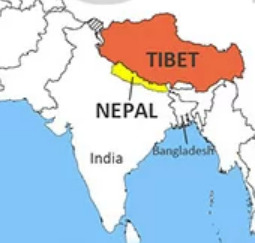
An important thing to note while discussing the cultures of this region is that all three modern countries have a lot of cultural overlap. So many of the foods eaten in one country are also eaten in the other two, with minor variations.
I'm attempting to generalize and speak broadly as best I can, but I am not an expert, so I apologize for any errors on my part. Sometimes finding English-language information on these topics is challenging.
The cuisine of Nepal is a mix of Nepal's own unique culture, plus the influence of its neighbors, India and Tibet.
The Nepali diet primarily consists of rice, wheat, corn, lentils coupled with fresh vegetables and meats. A typical Nepali every-day meal can be characterized by Dal (lentil soups), Bhat (steamed rice) and Tarkari (vegetables), also known as "The Trinity", supplemented by some meat.
STEW OR CURRY?
Though many people think of them as two distinct things, curries are a type of stew, so I think it's valid to look at both stews and curries when trying to identify Kabru's childhood stew.
TOMATOES IN THE CUISINE OF THE INDIAN SUBCONTINENT
Tomatoes turn up in dishes all over the Indian subcontinent, but they are not a traditional ingredient in the local cuisine. Europeans introduced New World foods like chilies, potato and tomato to the region in the 16th century, at which point they were added to the food culture, and in many cases the modern version of these recipes has completely eclipsed the traditional one, both on the Indian subcontinent and abroad.
But while potatoes and chilies were adopted almost immediately, the tomato did not catch on until centuries later, in the 1860s, and they did not become a widespread part of the local culture until the 1960s.
Because of this, the popular global idea of food from the Indian subcontinent often has tomatoes in it, while traditional recipes do not... And this is interesting because Kui tells us Kabru's favorite food is tomatoes! I'm guessing she chose tomatoes because of how common they are in modern Indian food.
Did Kui not know that tomatoes aren't a native part of the cuisine of the Indian subcontinent? It's possible her research didn't go that deep and she just assumed the modern food isn't that different from ancient food.
It's also possible that Kui knew that tomatoes aren't native to the Indian subcontinent, but that Dungeon Meshi has already experienced their version of the Colombian Exchange, because the east and west have had extensive contact with each other for (probably) thousands of years, so then the use of tomatoes in the West (where Kabru is from) would make sense, and doesn't need any further explanation.
MUTTON IN THE INDIAN SUBCONTINENT
Mutton (the term for goat, sheep or lamb meat) is the most consumed red meat in the Indian subcontinent. Goat is the most popular, most likely because it is the cheapest out of the three.
MUTTON IN NEPAL
Like in the rest of the subcontinent, mutton is very popular in Nepal. It is considered a major delicacy, and goat stew/curry is often eaten by Nepali families during important holidays, and for many Nepalis, goat stew/curry is associated with big family gatherings, similar to how Americans think of eating turkey for Thanksgiving, or ham for Easter.
Let's talk about some of the dishes anon(s) asked me about!
ROGAN JOSH
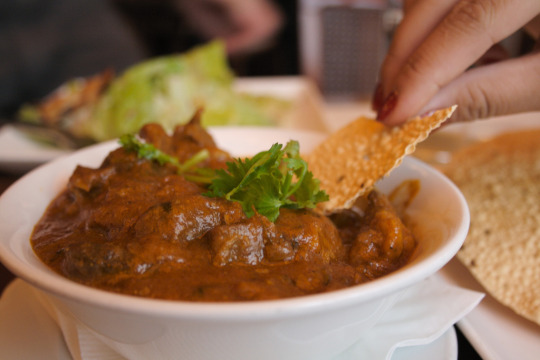
Rogan josh is an aromatic curried meat dish originating from Kashmir. It is made with red meat—traditionally mutton—and colored and flavored primarily by alkanet flower (or root) and Kashmiri chilies. It is one of the signature recipes of Kashmiri cuisine.
A number of origins/meanings of the name have been suggested, such as "stewed in ghee" or "red meat/red juice."
Its characteristic deep red color traditionally comes from dried flowers or root of Alkanna tinctoria (ratan jot) and from liberal amounts of dried, deseeded Kashmiri chilies (lal mirch).
Many modern interpretations of this dish add tomatoes to the sauce. This is especially common with ready-made pour-over cooking sauces to the point that Rogan josh is often described in the modern day as a tomato-based dish.
GORKHALI LAMB

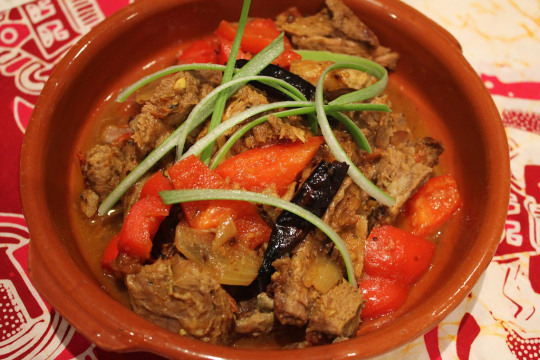
The word Gorkhali (गोर्खाली) is historically synonymous with "Nepali," so Gorkhali lamb could also be called Nepali lamb. The name change, from Gorkhali to Nepali, occurred in the 1930s.
(In the modern day, Gorkha is usually used to refer specifically to military units in the British or Indian army that were made up of men from the North Indian/Nepal region. Starting in 1816 the British East India Company frequently recruited these men as mercenaries, and over time the Gorkhas became very distinguished as exceptional soldiers.)
I couldn't find much about Gorkhali lamb aside from recipes, most of which just echoed the same information, and many of them didn't seem to come from very authentic sources.
From what I've been able to piece together, you make Gorkhali lamb by marinating lamb meat (usually meat on the bone) and cooking it over a charcoal grill. Once it's done, you coat the grilled lamb with a sauce made with chilies and tomatoes, and serve with rice or roti.
I'm not an expert, but it seems like Gorkhali lamb isn't a stew or a curry, it's a sort of marinated, grilled lamb with a sauce. If someone knows more about Gorkhali lamb, please let me know!
Like the Rogan Josh, the addition of tomatoes is a modern invention.
THUKPA
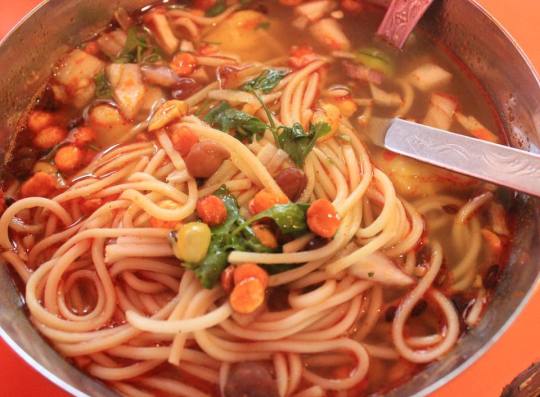
Thukpa is the Tibetan word for any soup or stew with noodles. Thukpa can be prepared in both vegetarian and non-vegetarian variations; the most popular non-vegetarian variation includes chicken, but it is sometimes made with mutton as well.
The Nepalese version of Thukpa is predominant vegetarian, and has a spicier flavor. The protein ingredients are replaced with vegetarian alternatives such as various types of bean.
However, non-vegetarian thukpa is also enjoyed in Nepal, and egg thukpa is probably the second most popular type.
Thukpa is made like most other noodle soups. Some modern recipes include tomatoes in the soup paste, most likely a modern addition.
INDIAN MUTTON CURRIES
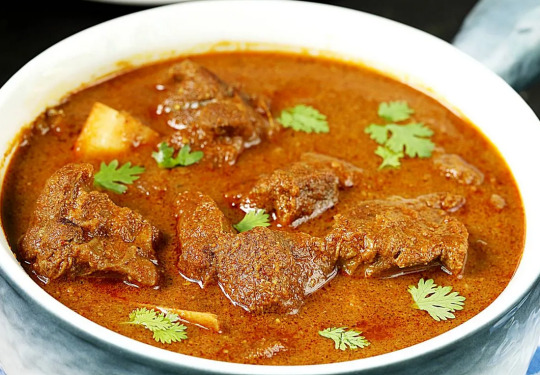
There's many different variations of mutton curry (Kosha mangsho, Mansa kasa, Tapelu, Rezala etc.) throughout the entire Indian subcontinent. Some recipes include tomato, some don't, and as with everything else in this post, the tomatos are a modern addition.
NEPALI MUTTON CURRY
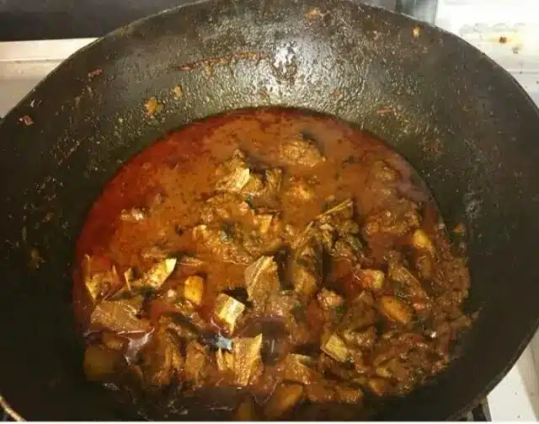
As I said before, mutton is incredibly popular in Nepal. It's reserved for special occasions and celebrations, like Dashain, Nepal's biggest festival. There are many different types of stew and curry in Nepal that feature mutton, and mutton is a popular meat to use in momos or fried rice as well.
SO WHAT IS KABRU'S GOAT STEW?
Unfortunately we still don't have enough information to give a definitive answer.
However, I would say that thukpa and Gorkhali lamb can both be ruled out, since noodles are the core of thukpa and Kabru doesn't mention that his stew is missing noodles. Meanwhile Gorkhali lamb doesn't seem to be a proper stew.
So then what we have left is Rogan josh, and Indian or Nepali mutton curries. Based on all the little tidbits we know, I'd be inclined to assume Kabru's stew is one of these Nepali curries, since they are so iconic of Nepali cuisine and are a big part of the local culture, and that seems to match what Kui tells us in the manga - that this food is a cherished childhood memory.
I've sprinkled some links throughout this post, but you can read more about Nepali mutton curry, and other Nepali food at all of these sites:
https://nepalicooking.tripod.com/lamb.htm
https://www.buzzfeed.com/anupkaphle/here-we-goat-again
https://www.buzzfeed.com/anupkaphle/keep-calm-and-curry-on
https://www.foodpleasureandhealth.com/nepali-style-goat-pakku/
MUSHROOM POSTSCRIPT: I have seen some people get confused by the goat stew page in the manga. They think that when Kabru says "my mother used to make this stew for me" he is talking about Milsiril, the elven woman who took care of him after his birth mother was killed.
Though we do not know 100% for certain, I think this is an objectively incorrect reading of the text. I may make a more comprehensive post about this another time, but:



Kabru says he ate this stew as a child, that he hasn't had it in a long time, and that he's looking forward to having it again. He says he is relying on childhood memories in order to make the stew.
If this stew is something Milsiril made for him, why did she stop making it? Why hasn't Kabru had it in a long time? Was there a goat blight for the last 10 years? Did she stop making it to punish Kabru for wanting to leave her? This seems like important information Kui would have told us.
The much more logical assumption is that Kabru's birth mother, who died when he was 7, is the one that made lamb stew, and that's why Kabru hasn't had it in a long time, struggles to remember how to make it, and also why he's so excited to eat it.
This is in direct contrast with the elf fruit cake that Milsiril forced Kabru to eat as a child. Kabru's birth mother made him something he loves, that he is eager to eat again, while Milsiril forced him to eat elf cake so often that it has become his most disliked food.
Kabru and Ryoko Kui never refer to Milsiril as Kabru's mother, the phrase “foster parent” (養母 or 育ての親が, lit. meaning “parent who raised me” in contrast with a birth/blood parent) is used instead in both the manga itself and in the World Guide.
There are several other things like this (how Kabru talks about Milsiril) which I think makes it clear that Kabru probably doesn't call Milsiril mother willingly, and that he goes out of his way to put distance between her and himself. He doesn't hate her, but he doesn't want her to be a part of his life.
Milsiril is a wealthy noble in a society where women are equal to men. It's unlikely that she personally does much cooking, and even if she does cook as a hobby, it's unlikely that Kabru watched her butcher a goat - servants or the butcher would prepare the meat for her.
Milsiril is a fussy eater, and hates most foods. Goat tends to have a strong flavor and is sometimes gamey. I don't think she'd eat goat... Meanwhile, as I stated previously, goat is a delicacy in Nepal, so it would make perfect sense for goat to be a special treat Kabru grew up eating.
Yes, Milsiril sometimes does things she doesn't want to do because Kabru asks... But both examples we have of this, she tries to turn it into a punishment. She explicitly says she's training Kabru so that he'll give up, not because she wants him to get strong and succeed. She wants him to fail. She takes him to her family reunion to prove to Kabru that it's unpleasant, so he won't want to go again. Both times this tactic doesn't work, but she clearly states that this is her intent.
I could go on about this for hours, but this post is really about goat stew!!! But just wanted to throw that in there in case anybody is confused about who exactly cooked goat stew for Kabru.
As I said, there's always the possibility that I'm wrong, but I think the evidence is pretty overwhelming that when Kabru says "my mother cooked this for me" he isn't talking about Milsiril.
#dungeon meshi#delicious in dungeon#kabru#dunmeshi#talking mushroom#dungeon meshi research#kabru of utaya#kabru dungeon meshi#analysis#The Essay#Dungeon Meshi Research
37 notes
·
View notes
Text
Tagged by @acrossthewavesoftime to list 5 topics I can talk on for an hour without preparing any material, thank you! (And my deepest apologies to everyone else who has tagged me in something that I have yet to do—I love being tagged, but don't have the greatest track record with following through).
The War of 1812. I have at LEAST an hour of off-the-cuff material. Do you want the naval war, the western frontier, the political machinations? Historic sites I want to visit? Participants I wish I could hug?
Frederick Marryat. I could easily talk for an hour about his life, his novels and their popular reception, and his travel writing. Just a fascinating guy who lived in a time of great transition and change! Would fight and/or hug him.
The Franklin Expedition. One of my oldest special interests, and there are always new discoveries to discuss! I would probably be talking about a lot of things adjacent to the Franklin Expedition that built the world that launched it: economic conditions in 1840s Britain, colonial wars, and scientific interest in things like surveying and terrestrial magnetism. Also which officers are the coolest. (Le Vesconte and Fitzjames, obviously).

The American Indian Wars. I keep running into this in my War of 1812 studies (and it's the same cast of characters in the late 18th and early 19th century). Depressing!
Favourite staple recipes and traditional food. Lobscouse, pea soup, and other ways you can eat like a 19th century sailor. I am sad to not have all of my cooking equipment in my tiny apartment kitchen (so much for steamed puddings!)
Tagging @radiojamming (and not just because I shamelessly stole their Two Men meme), @sanguinarysanguinity, @maudeboggins, @daltongraham, @gentlyepigrams, @victoriansecret, and @pagansphinx if you want to do it!
32 notes
·
View notes
Text
Plov is a rice pilaf-style dish that became popular in the Soviet Union by way of Uzbekistan. Plov’s popularity in Russia can be traced back to at least the time of Alexander the Great. Upon returning from Central Asia to Macedonia, his soldiers were said to have brought back plov as one of their new favorite foods. The existence of this dish in Central Asia has a distinct tie to the Jewish community there. The Bukharian Jews of Central Asia are Mizrahi Jews whose lineage goes back to the time of King David and ancient Persia. During the reign of Persia’s Cyrus the Great, Jews made their way to Central Asia and formed a community where they eventually spoke a dialect of Persian called Bukhori. Central Asian versions of plov, particularly the Uzbeki variety, were later popularized across all Soviet republics during the time of the Soviet Union.
Plov can be similar to Indian pulao or Spanish paella, though ultimately, there are countless cultures that have some version of a one-pot rice and meat dish.
Soviet-style plov is most commonly made with lamb as its meat, carrots as its vegetable, and is typically spiced with cumin and coriander. However, you will find a wide range of plov made with different kinds of meat or poultry, spices, and even the addition of dried fruits or nuts.
I prefer to keep plov simple with traditional flavors. I use chicken thighs for their availability and affordability, and add loads of carrots and onions, which seem to magically disappear into the rice once cooked. Garlic, bay, cumin and coriander perfume this plov. This dish is a one-pot meal. Once all of the ingredients are prepped, it comes together quickly and then gets popped into the oven to finish cooking. It reheats and freezes well, and is hearty and filling.
5 notes
·
View notes
Text
🍨What Flavor Cookie are you based on the BAKER ASTEROID? PT.2 🍡
🧁BAKER ASTEROID◇◇ 《2549》🧁
🥮🥮🥮🥮🥮🥮🥮🥮🥮🥮🥮🥮🥮🥮🥮🥮🥮🥮
DESCRIPTION: The baker asteroid is said to be the bakers asteroid for baked goods and even bakers themselves.
🧁🧁🧁🧁🧁🧁🧁🧁🧁🧁🧁🧁🧁🧁🧁🧁🧁🧁
Baker in Libra/7th house: I just get a loving vibe from this placement, either baker in libra likes to bake for their partner or your partner bakes for you( especially if it's in the 7th house) you could sell baked foods because libra does rule over merchandise and businesses. Venus influencing this y'all could have very beautiful techniques when baking especially if you decorate your cakes, cookies,etc. this placement has the ability to get very creative as well. I feel like y'all baking can be very good but kinda on the healthier side as well. Also y'all could actually have a bakery store
Cookie: canestrelli cookies// madeleine cookies
Baker in Scorpio//8th house: imma keep it real this could go 1 of 2 ways y'all might either be a good or bad baker that's just what I was called to say. Or you could be good but you guys might add some sort of knowledge that you have leared abou/ baking or edgy touch into your baking. This could be a hidden talent you have. Unless this is in a certain house or sign it could vary. In the 8th house, I would definitely say like a hidden talent. A gift you inherited from your ancestors this could get really spiritual or occultic. Also you could constantly be burning your baked goods. But don't get me wrong here y'all food definitely could be very good just a little over cooked . I have this placement in the 8th house and I like baked sweets soft but a tad burnt. Y'all cookie will be interesting to come up with.
Cookie: white chocolate red velvet cookies/ brown butter Carmel cookie
Baker in Sagittarius/9th house: its kinda giving foreign baking vibes like y'all take recipes from foreign cultures. Very adventurous with your baking style. Exspansive flavourrrrrr 🤤, y'all give me professional chef/ baker vibes here . Blessed in baking, might even go to school for baking or travel to learn about baking. I feel like y'all can become experts in baking. My little alchemists got the perrrrfect recipes to make your tastebuds explode!
Not really a cookie but they're good asf : Galab jamun/Big Blue Monster stuffed cookie (he he he he 😉)
Baker in Capricorn/10th house : now if baker is in the SIGN Capricorn I feel like y'all baking can be good but very old school if you look at your cookie you'll see what I mean. If it's in the 10th house this could be your career or just something your known for. Baker here it may have taken you some time to master baking. But I feel like Capricorn/10th house could make some good bakers. Depending on aspects,degrees,house,signs it will vary. But like I said very old fashion but good. If it's badly aspected, I feel like the baking might be a little dry or brittle. But all in all you could be a professional baker.
Cookie: oatmeal raisins/loornadoone/ snicker doodle
Baker in Aquarius/11th house: Eccentric, creative, different. Aquarius can blow some minds away or may be horrible. (depending on aspects don't beat me up😓) . I feel like y'all a little spicy/tangy it's giving lemon meringue or like y'all the type to mix pb&j into a cookie or sum like that. This placement as well could make you very popular for your cooking online. Friends may know how to bake. Baking may even be a dream. You guys as well could have a bakers blog or just be popular on social media for that.
Cookie: churro chocolate stuffed cookies/ pb& j cookies
Baker in Pisces/12th house: it's either lost or it's found here, y'all have it all or nothing. You either can bake your a$$ off or not. If you happen to be a good one then I feel like your really good you definitely could have the ability to heal others through your baking. But also since Neptune is here and Neptune rules 🍷🍺🥃💊🚬 there's a possibility of **cough cough** (edib----🌿🌿) im just being mindful if there's any kids reading this. These bakers could make comfort foods. Maybe even holistic,chemical free baked foods. I feel like this placements food could taste good and take your your taste buds to outerspace. 🤗😇
Cookies: raspberry swirl cream cheese cookie/ cosmic brownie cookies
#asteroid#astro notes#natal chart#astrology posts#occult#baker's#foodstrology#astro community#libra#capricorn#sagittarius#scorpio#aqaurius#pisces
132 notes
·
View notes
Text
In the 19th century, British colonists faced several challenges in India, [...] [including] malaria. [...] The imperialists needed an answer to the problem and they found it in quinine. [...] [T]he British promptly embraced quinine, consuming tonnes of it every year by the mid-1800s. [...] Quinine was so bitter that soldiers and officials began mixing the powder with soda and sugar, unwittingly giving birth to “tonic water”. [...] [I]t prompted Winston Churchill to once proclaim, “The gin and tonic has saved more Englishmen’s lives, and minds, than all the doctors in the Empire.” [...] If by some good fortune malaria did not claim them, plague, cholera, dysentery, enteric fever, hepatitis or the unforgiving sun could. Preserving and protecting the body was [...] crucial to the success of the colonial project. As historian EM Collingham aptly summarised in her study, “The British experience of India was intensely physical.”
One way the colonists tried to deal with this challenge was through food and drinks. “The association between food and the maintenance of health was a concern of Anglo-Indian doctors, dieticians and the British authorities throughout the duration of colonial rule [...],” writes Sam Goodman in Unpalatable Truths: Food and Drink as Medicine in Colonial British India. [...]
---
The Medical Gazette, for instance, recommended treating dysentery with a “low diet” comprising thin chicken soup [...]. Botanist-physician George Watt too extolled the virtues of sago. In A Dictionary of the Economic Products of India (1893), he wrote that sago is “easily digestible and wholly destitute of irritating properties” and in demand [...]. For fever, weakness and sundry ailments, beef tea [...] was considered an ideal remedy. And for cholera, The Seamen’s New Medical Guide (1842) prescribed brandy during the worst of the sickness and half a tumbler of mulled wine with toasted bread and castor oil [...]. Ship masters and pantrymen would stock their vessels with foods with known medicinal benefits such as sago, arrowroot, lime juice, desiccated milk and condensed milk (the iconic Anglo Swiss Condensed Milk tins, later known as Milkmaid, enjoyed a permanent spot on British ships).
---
Businessmen too recognised the precarity of life abroad and realised that therein lay a perfect commercial opportunity. By the 19th century, numerous companies had cropped up across Europe, including in England, that would sell food in hermetically sealed tin containers.
One of these was Messrs Brand & Co. Recommended highly in Culinary Jottings for Madras by Colonel Robert Kenney-Herbert, Messrs Brand & Co had several offerings [...]: essence of beef, concentrated beef tea, beef tea jelly, meat lozenges, [...] potted meat, York and game pie, and A1 sauce [...]. Another company, John Moir & Sons, focused mostly on canned soups [...], selling oxtail, turtle, giblet and hare.
---
By the late 19th century such was the popularity of canned foods that rare would be the pantry in a colonial home that didn’t store them along with medical provisions like opium, quinine, chlorodyne and Fowler’s solution (an arsenic compound). [...] As Flora Steele and Grace Gardiner wrote in The Complete Indian Housekeeper and Cook, “A good mistress will remember the breadwinner requires blood-forming nourishment, and the children whose constitutions are being built up day by day, sickly or healthy, according to the food given them; and bear in mind the fact that in India, especially, half the comfort of life depends on clean, wholesome, digestible food.”
To assist the British woman in this ostensible duty, there were a number of cookbooks and housekeeping manuals [...]. The Englishwoman in India, for instance, published in 1864 under the pseudonym A Lady Resident, had a whole section with recipes for “infants and invalids”. These included carrot pap cooked into a congee with arrowroot [...] and toast water (well-toasted bread soaked in water). Steele and Gardiner too had a few recipe recommendations [...], including champagne jelly (“most useful in excessive vomiting”) and the dangerous-sounding Cannibal Broth (beef essence), which they said should be consumed with cream [...] to treat extreme debility and typhoid. [...]
---
One dish born of this encounter was the pish pash. The pish pash is considered an invention of the colonial cook, who adapted the kedgeree – the colonial cousin of khichdi – into a light nursery food. The famous Hobson-Jobson defined it as “a slop of rice soup with small pieces of meat” [...]. None other than Warren Hastings, the first governor-general of Bengal, gave confirmation of its efficacy when in 1784 he wrote to his wife from the sick bed [...]. There are enough records to show that the imperialists counted marh (starch water from cooked rice) and bael (wood apple) sherbet among their go-to remedies and benefited from the medicinal qualities of chiretta water and ajwain-infused water.
---
All text above by: Priyadarshini Chatterjee. “How food came to the rescue of the British in India.” Scroll.in (Magazine format). 26 April 2023. [Bold emphasis and some paragraph breaks/contractions added by me.]
107 notes
·
View notes
Text
Discover Delicious Vegetarian Recipes Today
Are you ready to dive into the world of vegetarian cooking? This guide is your key to a world of tasty vegetarian recipes. Whether you're already a fan of plant-based food or just starting, you'll find lots of ideas to excite your taste buds and keep you healthy.
Looking for hearty main dishes or tasty sides? This guide has everything you need to make amazing vegetarian meals. Your family and friends will love them. Learn how to make vegetarian dishes that are not only healthy but also incredibly flavorful.

Key Takeaways
Discover a wide range of delicious vegetarian recipes to suit every palate and occasion
Learn about the health benefits and environmental advantages of embracing a vegetarian lifestyle
Explore diverse vegetarian cuisines from around the world
Discover easy ways to find and access vegetarian recipes online
Unlock the secrets to building a balanced and nutritious vegetarian meal plan
Benefits of Embracing a Vegetarian Lifestyle
Choosing a vegetarian diet brings many benefits. It can make you healthier and help the planet. Learning about these perks might encourage more people to try a vegetarian lifestyle.
Health Advantages
A vegetarian diet is packed with health benefits. People who eat plants often face lower risks of heart disease, diabetes, and some cancers. Eating lots of fruits, veggies, and whole grains can make you feel better overall.
Environmental Impact
Switching to a vegetarian or plant-based diet is great for the environment. Animal farming causes a lot of pollution, uses a lot of land, and wastes water. By eating less meat, you can cut down on pollution and help the planet.
MetricVegetarian DietOmnivorous DietGreenhouse Gas Emissions1.5 tons CO2eq/year2.5 tons CO2eq/yearLand Use0.5 hectares/person1 hectare/personWater Consumption1,000 liters/day2,000 liters/day
The table shows how a vegetarian diet is better for the environment than eating meat.
"Embracing a vegetarian lifestyle is not only good for our health, but it also helps protect the planet. It's a win-win situation that everyone should consider."
Exploring a Wide Range of Vegetarian Cuisines
The world of vegetarian cuisine is full of flavors and traditions from around the globe. You can find everything from Indian curries to Mediterranean dishes. There's a lot of delicious vegetarian recipes to try.
Indian��vegetarian cuisine is especially notable. It's known for its spices, lentils, and vegetables. Dishes like saag paneer, chana masala, and vegetable biryani are loved by many. They show how amazing plant-based cooking can be.
In the Mediterranean, you'll find a variety of global vegetarian dishes. There are Greek salads, Italian pasta primavera, Spanish gazpacho, and Lebanese fattoush. These dishes are not only tasty but also beautiful to look at.
"Vegetarian cooking is no longer niche; it's becoming mainstream. It's about the 'culture' of food, not just a diet characterized by what you avoid."
- Yotam Ottolenghi, acclaimed chef and author
Exploring doesn't stop there. Asian cuisines like Japanese miso soup and Thai red curry offer many vegetarian options. And Latin American dishes, such as Mexican tamales and Brazilian feijoada, can also be made vegetarian.
Whether you're looking for classic dishes or something new, vegetarian cuisine has it all. It's a world of plant-based recipes that celebrate nature's best.
https://www.youtube.com/watch?v=zn4SeGRYMGg
find vegetarian recipes Easily Online
Finding tasty vegetarian recipes online is super easy today. Whether you're an experienced plant-based chef or just starting, the internet has lots to offer. You can find amazing meatless meals on recipe websites and social media.
Popular Recipe Websites
Looking for vegetarian recipes online? There are top websites known for their great collections and easy-to-use designs. Here are some of the best vegetarian recipe websites:
Minimalist Baker: They offer simple, tasty plant-based recipes for any time.
Cookie and Kate: This site has healthy, vegetarian dishes that many love.
Oh She Glows: Angela Liddon's website is full of yummy, healthy vegetarian and vegan recipes.
Vegetarian Social Media Influencers
Vegetarian social media influencers also offer great inspiration. They share their favorite dishes, cooking tips, and lifestyle ideas. This helps grow a community of vegetarian fans. Here are some famous vegetarian social media influencers:
Deliciously Ella: Ella Mills shares her vibrant, plant-based cooking on Instagram and YouTube.
Niomi Smart: Known for her vegetarian recipes and wellness tips, she has a big following.
The Buddhist Chef: Jean-Philippe Cyr's Instagram and website show his love for meatless, Buddhist food.
Looking for new recipes, meal ideas, or a vegetarian community? The online world has lots to offer. By exploring these resources, you'll find a world of tasty and healthy vegetarian recipes to enjoy.
Building a Balanced Vegetarian Meal Plan
Choosing a vegetarian lifestyle has many health perks. But, it's key to make sure your diet is full of essential nutrients. A well-thought-out vegetarian meal plan can greatly benefit your health.
Incorporating Essential Nutrients
As a vegetarian, you need to pay extra attention to nutrients like protein, iron, calcium, and vitamin B12. Luckily, you can easily add these nutrients to your meals with a bit of planning.
Protein-rich options: Legumes, tofu, tempeh, seitan, and a variety of nuts and seeds.
Iron-rich foods: Leafy greens, lentils, quinoa, and fortified cereals.
Calcium-rich choices: Dairy-free milk alternatives, leafy greens, and fortified plant-based foods.
Vitamin B12 sources: Nutritional yeast, fortified plant-based milks, and supplements (if needed).
By focusing on a��balanced vegetarian meal plan, you can make sure your body gets all the nutrients it needs. This way, you can thrive on a plant-based diet.
NutrientVegetarian SourcesRecommended Daily IntakeProteinTofu, tempeh, lentils, beans, nuts, seeds46-56 grams per dayIronSpinach, cashews, quinoa, fortified cereals8-18 milligrams per dayCalciumKale, broccoli, tofu, plant-based milk1,000-1,200 milligrams per dayVitamin B12Nutritional yeast, fortified plant-based milk2.4 micrograms per day
By eating a variety of plant-based foods, you can make a balanced vegetarian meal plan. This plan supports your health and well-being.

"A well-planned vegetarian diet can meet all the nutrient needs of the body and provide numerous health benefits."
Meat-Free Alternatives for Classic Dishes
Vegetarian living doesn't mean giving up on tasty dishes. Thanks to vegetarian substitutes for meat and plant-based alternatives, making meatless versions of classic recipes is easy. Discover hearty, satisfying meat-free options that even meat lovers will enjoy.
Lentils are a great substitute for ground beef. They have a meaty texture and can taste like traditional beef in tacos, chili, and shepherd's pie. Mushrooms are also versatile. They can make savory, umami-rich "meat" substitutes in burgers and Bolognese.
Vegetarian SubstituteClassic Dish EquivalentLentilsGround beef in tacos, chili, shepherd's pieMushroomsBurgers, Bolognese sauceSoy-based crumblesGround beef in tacos, spaghetti BologneseJackfruitPulled pork in barbecue sandwiches
Soy-based crumbles offer a meat-like texture. They can replace ground beef in many dishes, like tacos and spaghetti Bolognese. Jackfruit is also a surprising substitute for pulled pork.
With these vegetarian substitutes for meat and plant-based alternatives, you can make endless meatless versions of classic recipes. Try different ingredients and flavors to find your favorite meat-free dishes.
Time-Saving Vegetarian Meal Prep Tips
Vegetarian meal prep is a big help for those who are always on the go. It lets you enjoy tasty, plant-based meals without the stress. By learning vegetarian meal prep and batch cooking, you can make cooking faster and save time during the week.
Batch Cooking and Meal Prepping
Batch cooking is a top way to save time for vegetarians. It means making lots of one dish or part at once, like roasted veggies, lentil stews, or grain salads. Spending a few hours on the weekend on batch cooking can fill your fridge and freezer with vegetarian meal prep goodies. This makes dinner time on busy weeknights much easier.
Find your favorite vegetarian recipes that are great for batch cooking, like soups, curries, and casseroles.
Set aside a few hours on a weekend to cook these dishes in big batches.
Put the meals into individual servings or containers for easy access.
Freeze the leftovers for later, so you always have time-saving vegetarian cooking options.
Meal prepping is another smart way to prep for vegetarian meal prep. It means getting your meals or parts ready ahead of time and storing them. Having these parts ready lets you quickly make a healthy, tasty vegetarian meal with little effort.

"Meal prepping has been a game-changer for my vegetarian lifestyle. It allows me to enjoy delicious, home-cooked meals without the daily stress of deciding what to make."
With a fridge and freezer full of batch cooking and meal prepped vegetarian dishes, you can easily get through weeknights. You'll enjoy your favorite plant-based meals without the hassle of long prep times.
Delicious and Versatile Plant-Based Ingredients
Discover the world of tasty and versatile plant-based ingredients. They can make your vegetarian cooking even better. From superfoods to exotic spices, there's a world of flavors to explore.
Exploring Unique Flavors
Expand your cooking skills by using a wide range of versatile plant-based ingredients. Try ancient grains like quinoa, farro, and bulgur. They add texture and are full of nutrients.
Use spices like cumin, turmeric, and cardamom to explore new flavors in vegetarian cooking. They bring bold and aromatic tastes to your dishes.
Legumes like lentils, chickpeas, and black beans are very versatile. They can be used in stews or as dips. Also, ingredients like tempeh, seitan, and miso add depth to your meals.
Versatile Plant-Based IngredientUnique Flavor ProfileCulinary ApplicationsQuinoaNutty, slightly earthySalads, pilafs, grain bowlsTurmericWarm, slightly bitter, slightly sweetCurries, rice dishes, roasted vegetablesChickpeasCreamy, slightly nuttyHummus, roasted snacks, stews
Use the versatile plant-based ingredients and unique vegetarian ingredients you have. Let your creativity shine as you explore new flavors in vegetarian cooking. The possibilities are endless!
Vegetarian Recipes for Special Occasions
Make your vegetarian recipes for parties, meatless holiday dishes, and plant-based entertaining stand out with tasty options. These dishes will wow your guests, even if they love meat. They're perfect for dinner parties or big feasts.
Try a Butternut Squash Wellington for a stunning centerpiece. It has a flaky crust and a mix of mushrooms and lentils inside. It's great for Thanksgiving or Christmas.
Add color and taste to your vegetarian recipes for parties with a Roasted Vegetable Tart. It's filled with bell peppers, zucchini, and onions in a buttery crust.
For a meatless holiday dishes spread, make a Lentil and Sweet Potato Shepherd's Pie. It's warm, filling, and loved by all.
Wow your guests with Quinoa and Black Bean Stuffed Portobello Mushrooms. It's a tasty, protein-rich plant-based entertaining choice.
Take your vegetarian cooking to the next level. Create unforgettable vegetarian recipes for parties, meatless holiday dishes, and plant-based entertaining moments for your family and friends.
Catering to Dietary Restrictions
In the world of vegetarian cooking, it's key to meet different dietary needs. You can make gluten-free or dairy-free meals that taste great. Plant-based ingredients offer endless options for satisfying meals for all.
Gluten-Free Vegetarian Dishes
Gluten-free folks don't have to miss out on tasty vegetarian dishes. Try using quinoa, buckwheat, and millet as bases for your meals. Add fresh veggies, legumes, and herbs for a flavorful, gluten-free meal.
Dairy-Free Vegetarian Meals
Those avoiding dairy have plenty of tasty options. Use plant-based milks like almond, cashew, or soy milk to make dairy-free versions of favorite dishes. You can make everything from savory meals to sweet treats with these ingredients.
By offering gluten-free vegetarian dishes and dairy-free vegetarian meals, everyone can enjoy the deliciousness of vegetarian food. It's all about making sure everyone has something they can eat and enjoy.
Eco-Friendly and Sustainable Vegetarian Cooking
As we become more aware of our environmental impact, adopting a sustainable vegetarian lifestyle is key. It helps reduce our carbon footprint and supports a healthier planet. By using eco-friendly and sustainable practices in cooking, we can enjoy tasty, environmentally-friendly meals and make a difference.
Sustainable vegetarian cooking has a big environmental advantage. Plant-based diets are often better for the planet than meat-based ones. This is because animal products need a lot of land, water, and energy to produce. Choosing eco-conscious vegetarian meals helps cut down on greenhouse gases, saves natural resources, and supports sustainable farming.
Choosing the right ingredients and methods is also important in sustainable vegetarian cooking. Using local, seasonal produce and reducing food waste are big steps. Also, using sustainable cooking techniques like energy-efficient appliances or composting can make our cooking more eco-friendly.
Eco-Friendly Vegetarian PracticesBenefitsBuying local and seasonal produceReduces carbon footprint from transportation and supports local economiesMinimizing food wasteConserves resources and reduces the environmental impact of food productionUtilizing energy-efficient cooking methodsLowers energy consumption and greenhouse gas emissionsComposting food scrapsDiverts organic waste from landfills and creates nutrient-rich soil for gardening
By choosing sustainable vegetarian cooking, we can enjoy tasty, environmentally-friendly plant-based meals and help the planet. Let's dive into the eco-conscious vegetarian lifestyle and see how we can nourish our bodies and the environment.
Conclusion
In this guide, you've found many tasty vegetarian recipes and the benefits of a plant-based lifestyle. Whether you're already a vegetarian or just starting, you now know how to make healthy and tasty dishes. These dishes will make you happy and keep you healthy.
This article has shown you the health and environmental benefits of a vegetarian diet. You've also learned about different vegetarian cuisines. Now, you can easily add more plant-based meals to your day. With online resources and meal planning, you can live a balanced vegetarian lifestyle.
Keep exploring vegetarian cooking by trying new ingredients and saving time with meal prep. You can also make recipes for any dietary needs. By enjoying vegetarian cooking, you're helping your body and the planet. Enjoy your meals!
FAQ
What are the health advantages of a vegetarian diet?
A vegetarian diet can help you avoid chronic diseases. It also improves heart health and helps with weight management. Plus, it can increase your life span.
How can a vegetarian diet impact the environment?
A plant-based diet is better for the planet. It has less carbon footprint and uses less land and water. It also makes fewer greenhouse gases than meat-based diets.
What are some popular vegetarian cuisine styles from around the world?
Vegetarian food is enjoyed globally. You can find traditional Indian curries and Mediterranean dishes. There are also modern Japanese and hearty Scandinavian options. Exploring these cuisines offers a world of tasty vegetarian meals.
Where can I find delicious vegetarian recipes online?
Many websites and social media influencers share great vegetarian recipes. Check out Minimalist Baker, Oh She Glows, and Deliciously Ella for inspiration.
How can I ensure my vegetarian diet is well-balanced?
To get all the nutrients, eat a variety of plant-based foods. Include beans, lentils, tofu, leafy greens, and fortified products. This ensures you get enough protein, iron, calcium, and vitamin B12.
What are some meat-free alternatives for classic dishes?
You can make vegetarian versions of favorite dishes. Try bean-based burgers, mushroom-based "meat" crumbles, and lentil-based shepherd's pie. These alternatives are tasty and satisfying.
How can I make vegetarian meal prep easier?
Use batch cooking and meal prep to simplify your vegetarian meals. Cook big batches of grains, roasted veggies, and proteins. This way, you can quickly make healthy meals all week.
What are some unique and versatile vegetarian ingredients to explore?
Discover new ingredients like quinoa, tempeh, jackfruit, nutritional yeast, and ethnic spices. These add flavor and nutrients to your dishes.
What are some delicious vegetarian recipes for special occasions?
For special events, try impressive vegetable dishes and decadent desserts. These vegetarian recipes can make your menus stand out, whether it's a dinner party or holiday feast.
How can I accommodate dietary restrictions in my vegetarian cooking?
Vegetarian cooking is great for different diets, like gluten-free and dairy-free. Find recipes that fit these needs. This way, everyone can enjoy healthy, plant-based meals.
How can I make my vegetarian cooking more eco-friendly?
To cook more sustainably, choose local and seasonal produce. Reduce food waste and use energy-efficient cooking methods. These actions help reduce your carbon footprint and support a healthier planet.
6 notes
·
View notes
Note
Here to ask for a recipe! Lots of love
Here is one of my comfort foods. It's called tehri. I found an english recipe online for it.
At our home we usually have it with green garlic coriander chutney and/or raita but it differs from household to household. Some people just put some ghee and have it as is. Some people have it with pickle (the Indian kind, NOT to be confused with the American kind because they're two very different things xD)
I personally love to have it with the green chutney and dahi pyaaz (a kind of raita which has curd, onions, chilli powder and salt). I sometimes also love the simply ghee version and have that often as well.
Tehri recipe:
I also found a chutney recipe (we don't use cumin or peanuts personally but it's up to you if you want to add that): https://www.indianhealthyrecipes.com/cilantro-chutney/
Hope that's helpful 🩷🩷🩷
6 notes
·
View notes
Text



National Rice Pudding Day
All we can think of is a bowl of some good old rice pudding this National Rice Pudding Day taking place on August 9. For many of us, starting from our childhood to our adulthood, rice pudding has been a staple in our diets. Made with a base of rice cooked in milk and sweetened with sugar, syrup, or honey, rice pudding can be found in many cultures and cuisines all over the world. Of course, each region has its own unique take on the dish. Some add nuts and spices like nutmeg, cinnamon, or cardamom to it, while others throw in a dash of wine to give it that wow factor. For a more fragrant look and feel, many people in the Middle East also add pistachio slivers and rose petals before serving it. You can have it hot or cold, and as a breakfast dish or a dessert after dinner. So, how are you having your rice pudding on August 9?
History of National Rice Pudding Day
National Rice Pudding Day celebrates the ancient rice pudding dish in all its glory and greatness. While we may know the sweet version of the dish today, did you know that it actually started out as a savory treat? It is difficult to pinpoint the exact location and time of the creation of rice pudding, but many scholars believe it may have originated in either ancient China or in ancient India. Both these countries have a long history of including rice as well as sugar in their religious and cultural activities, so it only makes sense that the combination of the two may have been included in their cuisines as well. ‘Kheer,’ which is Hindi for rice pudding, was first recorded in ancient India in 6000 B.C., and it was included as a staple in a prescribed Ayurvedic diet regime. It is also interesting to note that the early versions of the Indian rice pudding did not actually include rice or sugar. In place of rice, Indians made use of the cereal grain known as sorghum.
Elsewhere in the world, rice pudding was being made with rice. The grain had reached Europe through exports delivered by water or the Silk Road in the 1300s. Because it was being exported from Asia and was not being grown in Europe, rice automatically became extremely expensive. Thus, rice pudding could only be enjoyed by the elite and royalty of European countries. Before the 1500s, rice pudding was savory in nature. It was made with rice being boiled in a broth with saffron and almond milk. Chefs started including sugar into the dish to make it sweet, and soon a sweetened rice pudding started gaining popularity. It was in the eighteenth century that rice pudding became more commonplace and less expensive, all thanks to globalization. The lowered rice prices meant the grain was in easier reach of the masses, and in today’s world, it is considered to be a cheap, but filling meal.
National Rice Pudding Day timeline
6000 B.C. Indian Rice Pudding for Healthy Living
Ancient India includes rice pudding in the Ayurvedic diet in order to ensure healthy living.
14th Century Forme of Cury in England
Rice pudding, known as Forme of Cury or rice pottage, is made with rice, almond milk, and saffron in English Royal kitchens.
17th Century Sweetened Rice Pudding Recipes
Some of the modern-age rice pudding recipes come from the Tudor time period, and are called ‘whitepot.’
18th – 19th Century Rice Becomes Cheaper
Rice grains become cheaper, allowing access to the public who can now enjoy rice pudding treats, unlike their predecessors.
How To Celebrate National Rice Pudding Day
Make rice pudding
Have a rice pudding contest
Try a new rice pudding recipe
Take a trip down memory lane and make your favorite rice pudding recipe. Because of its versatility, you can choose to have it hot or cold, and for breakfast, lunch, or dinner. Rice pudding is one of the highest-rated comfort foods out there because of its gooey, yet grainy texture that leaves one filled with love and warmth.
Participating in a rice pudding competition is one of the best ways to celebrate the day. There are two ways you can go about doing this. You can either hold a rice pudding cooking competition or you can have an eating competition. Whether you choose one, two, or have both, it’s going to be a fun-filled day.
Going back to what is tried and tested can be comforting, but seeking out the new can reward you with invaluable experiences. Give new rice pudding recipes a try. It could be a sweet or a savory recipe, the choice is yours.
5 Facts About Rice That Will Blow Your Mind
Sticky rice for strong cement
White rice is brown rice
Rice is grown everywhere but Antarctica
The shelf-life is decades long
Good for health
The Great Wall of China is held together with sticky rice that has been mixed with calcium carbonate.
All white rice comes from brown rice, and this is because the white rice has the brown coating of bran removed.
Rice is grown everywhere except Antarctica because of the continent’s extremely cold temperatures.
Rice, when stored in a cool and dry environment, will be good to consume for the next 10 to 30 years.
Because rice contains several minerals and antioxidants, it is great for your health, particularly for your skin.
Why We Love National Rice Pudding Day
It’s a celebration of rice pudding
It’s a celebration of ancient times
It’s a celebration of a staple food item
Rice pudding has come a long way in terms of development. It has been enjoyed by millions for centuries. With easy-to-make recipes and simple yet enjoyable taste, rice pudding is loved by many all over the globe.
A look into ancient history will reveal a lot of information on how people led their lives in order to ensure healthy and peaceful living. One historical overview of rice pudding allows us just that benefit of looking into how human civilizations utilized a single rice pudding dish in their daily lives.
Rice is a staple food item for many countries in the world. In fact, 50% of the world’s population consumes rice on a daily basis. Apart from helping our skin stay smooth and supple, rice also aids in healthy hair, is good for our overall health, and keeps our tummies filled and happy.
Source
#National Rice Pudding Day#NationalRicePuddingDay#9 August#food#dessert#Spain#España#Rice pudding with cinnamon#vacation#travel#original photography#tourism#summer 2021#national food#spoon#plate#glass bowl#Southern Europe#Milchreis#Arroz con leche#restaurant
5 notes
·
View notes
Text
10 Most Popular North Indian Dishes
North Indian cuisine is known for its rich flavors and aromatic spices. Some of the 10 most popular North Indian dishes include Butter Chicken, a creamy chicken curry; Rogan Josh, a spicy lamb dish from Kashmir; and Chole Bhature, a flavorful chickpea curry served with deep-fried bread. Other favorites are Paneer Tikka, Aloo Paratha, Dal Makhani, Tandoori Chicken, Kadhai Paneer, Naan, Lassi, and Pulao, all of which offer a delightful mix of savory, spicy, and creamy tastes. Each dish reflects the diverse culinary traditions of the region and is loved by people across the world. Experience the best of North Indian Food at Chulha Chauki Da Dhaba while in Bangalore. The restaurant is not just worthy for its food but ambience, hygiene, and top class services.
2 notes
·
View notes
Text
Private Label Food Manufacturers: The Secret Behind Store Brand Success
In the dynamic world of retail, store brands are increasingly dominating the shelves, offering consumers quality products at competitive prices. Behind the scenes, private label food manufacturers play a pivotal role in the success of these store brands. As the demand for private label products continues to rise, understanding the significance of private label manufacturers, especially in India, becomes crucial for both retailers and consumers.

Unveiling the Concept of Private Label Manufacturing
Private label manufacturing involves the production of goods by one company for another, who then sells the product under its own brand name. In the realm of food products, private label food manufacturers act as the silent architects, creating a wide array of products for retailers to market as their own. This concept is gaining traction globally, and India is no exception.
The Rise of Private Label Manufacturers in India
Private Label Manufacturer in India: India, with its diverse consumer base and rapidly evolving retail landscape, has witnessed a surge in the prominence of private label manufacturing. Retailers are increasingly recognizing the potential of having their own brands, allowing them to differentiate and control their product offerings.
Advantages of Private Labelling Services
1. Cost Efficiency: Private label manufacturing often translates to cost savings. By working directly with manufacturers, retailers can cut out the middleman and reduce production costs, enabling them to offer competitive prices to consumers.
2. Brand Control: Retailers have the freedom to control every aspect of their brand, from packaging design to product specifications. This control allows them to tailor products to meet the specific needs and preferences of their target audience.
3. Flexibility and Innovation: Private label manufacturers provide retailers with the flexibility to experiment with new flavors, packaging, and trends. This agility allows store brands to stay ahead of the curve and respond swiftly to changing consumer preferences.
Private Label Food Manufacturer: The Heart of Store Brands
Private Label Food Manufacturer: These specialized manufacturers are the backbone of the private label ecosystem. They collaborate closely with retailers to bring a diverse range of food products to the market. From snacks and beverages to canned goods and frozen items, private label food manufacturers are adept at producing a wide variety of products.
The Process of Private Label Food Manufacturing
1. Product Development: The journey begins with collaborative product development. Retailers work closely with private label food manufacturers to create unique recipes and formulations that align with market trends and consumer demands.
2. Quality Assurance: Private label manufacturers prioritize quality to build and maintain the trust of both retailers and consumers. Stringent quality control measures are implemented throughout the production process to ensure consistency and safety.
3. Packaging and Branding: The visual appeal of a product is crucial. Private label manufacturers assist retailers in designing attractive packaging that not only stands out on the shelves but also communicates the brand's identity effectively.
Success Stories: Private Label Brands in India
Several success stories in the Indian retail sector exemplify the impact of private label manufacturing:
1. Grocery Chains: Leading grocery chains in India have embraced private label products across various categories, including staples, snacks, and beverages. The ability to offer quality products at competitive prices has contributed to the popularity of these store brands.
2. Online Retail Platforms: E-commerce platforms have also recognized the potential of private label manufacturing. By leveraging private label services, online retailers can build a distinct identity and enhance customer loyalty.
Challenges and Opportunities
While private label manufacturing presents numerous advantages, it is not without challenges. Maintaining a balance between cost-efficiency and quality, as well as establishing a unique brand identity, requires strategic planning. However, these challenges also present opportunities for continuous improvement and innovation within the private label sector.
The Future of Private Label Manufacturing
The future of private label manufacturing in India looks promising. As consumers become more discerning and value-conscious, retailers will continue to leverage private label services to provide high-quality, affordable products. The evolving landscape of the retail industry, coupled with the adaptability of private label manufacturers, sets the stage for sustained growth and success.
Conclusion
In conclusion, private label food manufacturers play a pivotal role in shaping the success of store brands. The symbiotic relationship between retailers and private label manufacturers in India has ushered in an era where consumers can enjoy quality products at affordable prices. As the private label landscape continues to evolve, it is evident that the secret behind store brand success lies in the collaborative efforts of retailers and the expertise of private label manufacturers.
#Private label food manufacturer#Private labelling services#Private label manufacturer in India#Condiments#Food Product Companies
7 notes
·
View notes